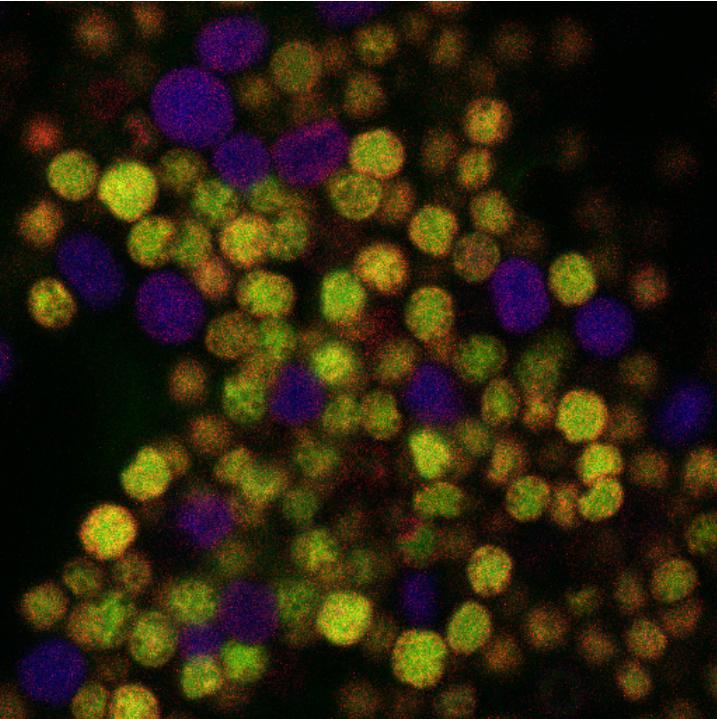Laboratory of Photosynthesis
Ondřej Prášil`s group
Microbial photosynthesis
Regulation of photosynthesis and N2 fixation in unicellular diazotrophic cyanobacteria
Single-cell regulation of N2 fixation and photosynthesis in filamentous cyanobacteria
N2 fixation – a major control on primary production
In aquatic environments, the availability of fixed nitrogen (N) is a key factor limiting primary and secondary production and exerts a fundamental control on the uptake of carbon dioxide. N2 fixation is the process that biochemically converts atmospherically abundant nitrogen gas (N2) into biologically available ammonium (NH4+). Among the oxygen-evolving photosynthetic organisms, only a handful of prokaryotic cyanobacteria are able to perform nitrogen fixation.
The paradoxical situation of N2 fixation and photosynthesis – O2 is toxic for N2 fixation
The appearance of oxygenic photosynthesis and consequently high levels of ambient O2 resulted in a paradoxical situation for anaerobic N2 fixation: O2 irreversibly inactivates the enzyme responsible for N2 fixation. Therefore, continuing N2 fixation - while also relying on oxygenic photosynthesis to provide energy and organic carbon (C) to sustain metabolism and growth - became the ultimate challenge for N2-fixing cyanobacteria. In our on-going projects on different groups of N2-fixing cyanobacteria (unicellular cyanobacteria such as Crocosphaera and Cyanothece, and filamentous cyanobacteria such as Trichodesmium), we investigate physiological strategies for meeting this challenge.
O2 management - How do unicellular diazotrophs accomplish to fix N2 and photosynthesize?

Some species of extant unicellular diazotrophic cyanobacteria (UCYN) such as Crocosphaera watsonii and Cyanothece spp. confine N2 fixation to night-time, when photosynthesis is “turned off”. We try to understand the mechanism underlying nocturnal inactivation of photosynthesis. Our data show that the decline in photosystem II activity and abundance was related to light-induced modification of photosystem II and suppressed synthesis of membrane proteins. We also tried to quantify the role of three O2 management strategies (size adjustment, reduced O2 diffusivity, and respiratory protection) by Crocosphaera watsonii. Our study shows that Crocosphaera increase their cell size and form a barrier for O2 along the cell wall by starch granules and thylakoid membranes under high O2. In addition, model results indicate a critical role for respiration in maintaining the N2 fixation rate.
- Related publications
- Inomura K., Deutsch C., Wilson S.T., Masuda T., Lawrenz E., Bučinská L., Sobotka R., Gauglitz J.M., Saito M.A., Prášil O., Follows. Quantifying oxygen management and temperature and light dependencies of nitrogen fixation by Crocosphaera watsonii. mSphere 4, e00531-19 (2019).
- Masuda T., Bernát G., Bečková M., Kotabová E., Lawrenz E., Lukeš M., Komenda J., Prášil O. Diel regulation of photosynthetic activity in the oceanic unicellular diazotrophic cyanobacterium Crocosphaera watsonii WH8501. Environ. Microbiol. 20, 546-560 (2018).
Energy trade-offs related to N2 fixation – Diazotrophs can be competitors for fixed Nitrogen

N2 fixation is energetically expensive since it requires additional energy costs for the nocturnal respiration in order to make cells anaerobic. On the other hand, under conditions of sufficient light (i.e. near the surface of the ocean) and under ample supply of inorganic C, the cells can accumulate as much C reserves as their cell size allows. We try to understand the effect of the nitrogen source on energy budget and growth of N2 fixers. Conventionally, N2 fixation is considered to be inhibited in the presence of dissolved inorganic nitrogen, such as NH4+ and NO3-. However, we have observed continuation of significant N2 fixation rates under conditions when NH4+ was available in Crocosphaera. Later, a collaborative study with modelers revealed that Crocosphaera can increase their population and expand their niche despite the presence of ammonium.
- Related publications
- Rabouille S.*, Campbell D.A. Masuda T., Zavřel T., Bernat G., Polerecky L., Halsey K.H., Eichner M., Kotabová E., Stephan S., Lukeš M., Claquin P., Bonomi-Barufi J., Červený J., Suggett D., Giordano M., Kromkamp J., Prášil (2021) Electron and biomass dynamics of Cyanothece under interacting nitrogen and carbon limitations. Frontiers in Microbiology. in print
- Inomura K., Masuda T., Gauglitz J.M. Active nitrogen fixation by Crocosphaera expands their niche despite the presence of ammonium – A case study. Scientific Reports 9, 15064 (2019)
- Masuda T., Furuya K., Kodama T., Takeda S., Harrison, P. J. Ammonium uptake and dinitrogen fixation by the unicellular nanocyanobacterium Crocosphaera watsoniiin nitrogen-limited continuous cultures. Limnology and Oceanography 58, 2029-2036 (2013)
Heterogeneous N2 fixation - One for all and all for one

Microbial communities, including cyanobacteria, consist of a genetically diverse assembly of different organisms, and the level of genetic diversity plays an important part in community properties and functions. However, biological diversity also arises at a lower level of biological organization, between genetically identical cells that reside in the same microenvironment. Even when genetic and environmental differences between cells are reduced as much as possible, single cells differ from each other with respect to gene expression and other phenotypic traits. This phenotypic heterogeneity can have important functional consequences, similar to the consequences of the biological diversity that emerge at higher levels of biological organization. We have observed such heterogeneity in both Crocosphaera and Cyanothece. Our data show that N2 fixation is confined to subpopulation of cells. Model results show that this heterogeneity helps to reduce energy costs at population level, and indicate that heterogeneous N2 fixation may be a strategy to sustain a population in nutrient-limited environments.
- Related publications
- Polerecky L., Masuda T., Eichner M., Rabouille S., Vancová M., Kienhuis M.V.M., Bernát G., Bonomi-Barufi J., Campbell D.A., Claquin P., Červený J., Giordano M., Kotabová E., Kromkamp J., Lombardi A.T., Lukeš M., Prášil O., Stephan S., Suggett D., Zavřel T. and Halsey K.H.*(2021) Temporal patterns and intra- and inter-cellular variability in carbon and nitrogen assimilation by the unicellular cyanobacterium Cyanothece sp. ATCC51142. Frontiers in Microbiology. 12: 620915
- Masuda T., Inomura K., Takahata N., Shiozaki T., Sano Y., Deutsch C., Prášil O., Furuya K., Heterogeneous N2 fixation rates confer energetic advantage and expanded ecological niche of unicellular diazotroph populations. Communications Biology, 3:172. https://doi.org/10.1038/s42003-020-0894-4 | www.nature.com